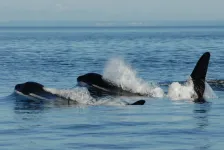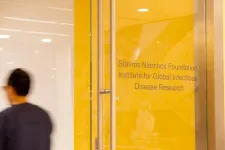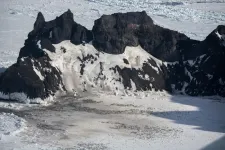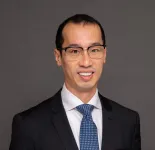(Press-News.org) Most babies begin recognizing themselves in mirrors when they are about a year and half old. This kind of self-recognition is an important developmental milestone, and now scientists at The University of Texas at Austin have discovered a key driver for it: experiences of touch.
Their new study found babies who were prompted to touch their own faces developed self-recognition earlier than those who did not. The research was published this month in the journal Current Biology.
“This suggests that babies pulling on their toes or tapping their fingers are not just playing,” said Jeffrey Lockman, a professor of human development and family sciences at UT and senior author on the paper. “They are developing self-awareness through self-directed activity. I think this work demonstrates a possible mechanism by which self-recognition can develop based on active experience that human babies naturally generate.”
Researchers began by placing small vibrating discs on the foreheads and cheeks of toddlers when they were around 14 months old, before the usual age at which self-recognition occurs. In response to the vibration, the children would reach up and touch the disc. Next, researchers turned the children to face a mirror and watched as they reached up to touch the discs.
Researchers then had the children perform the standard mirror-mark test for self-recognition in which a small mark of paint or makeup was placed on each child’s face. If the child looked in the mirror and touched the mark on their own face or said words like their name or “me,” they demonstrated self-recognition.
Researchers also observed a control group of children who were exposed to the laboratory experience with mirrors but not the vibrating discs. Both groups were comparable at the beginning of the study and observed monthly until they recognized themselves or reached 21 months.
The children who touched their face more frequently recognized themselves in the mirror about two months earlier, on average, than when children typically first begin to recognize themselves in a mirror.
The study challenges a longstanding assumption that self-recognition in early childhood is somehow hardwired. For a long time, scientists believed early recognition in the mirror was a built-in function of human brains and those of our closest primate relatives, versus linked to sensory or motor experiences.
The researchers said the findings may have implications for interventions for children with motor development delays.
“Interventions for infants who have issues related to motor skills are typically focused on reaching for objects in the external world and manipulating them,” Lockman said. “These findings suggest that reaching to the body may be equally important and that exploring the body is the gateway to self-knowledge.”
Lisa Chinn of the University of Houston and Claire F. Noonan and Katarina S. Patton of Tulane University were also authors on the paper. Funding for the research was provided by the National Institutes of Health.
END
First recognition of self in the mirror is spurred by touch
New evidence reveals that young children learn self-awareness through experiences of touch
2024-03-13
ELSE PRESS RELEASES FROM THIS DATE:
Dartmouth engineering team discovers new high-performance solar cell material
2024-03-13
A Dartmouth Engineering-led study published in Joule reported the discovery of an entirely new high-performance material for solar absorbers—the central part of a solar cell that turns light into electricity—that is stable and earth-abundant. The researchers used a unique high-throughput computational screening method to accelerate the discovery process and were able to quickly evaluate approximately 40,000 known candidate materials.
"This is the first example in the field of photovoltaics where a new material has been found through this type ...
Advancing toward wearable stretchable electronics
2024-03-13
Small wearable or implantable electronics could help monitor our health, diagnose diseases, and provide opportunities for improved, autonomous treatments. But to do this without aggravating or damaging the cells around them, these electronics will need to not only bend and stretch with our tissues as they move, but also be soft enough that they will not scratch and damage tissues.
Researchers at Stanford have been working on skin-like, stretchable electronic devices for over a decade. In a paper published ...
Menopause explains why some female whales live so long
2024-03-13
Females of some whale species have evolved to live drastically longer lives so they can care for their families, new research shows.
The study focussed on five whale species that – along with humans – are the only mammals known to go through menopause.
The findings show that females of these whale species that experience menopause live around 40 years longer than other female whales of a similar size.
By living longer without extending their “reproductive lifespan” (the years in which they breed), these ...
Supply chain disruptions will further exacerbate economic losses from climate change
2024-03-13
UCL Press Release
Under embargo until Wednesday 13 March 2024, 16:00 UK time / 12:00 US Eastern time
Global GDP loss from climate change will increase exponentially the warmer the planet gets when its cascading impact on global supply chains is factored in, finds a new study led by UCL researchers.
The study, published in Nature, is the first to chart “indirect economic losses” from climate change on global supply chains that will affect regions that would have been less affected by projected warming temperatures.
These previously unquantified disruptions in supply chains will further exacerbate projected economic losses due ...
The SNF Institute for Global Infectious Disease Research announces new advisory board
2024-03-13
From identifying the influenza virus that caused the pandemic of 1918 to developing vaccines against pneumococcal pneumonia and bacterial meningitis in the 1970s, combating infectious disease has a rich history at Rockefeller. That tradition continues as the Stavros Niarchos Foundation Institute for Global Infectious Disease Research at Rockefeller University (SNFiRU) caps a successful first year with the establishment of a new advisory board.
This international advisory board was created in part to give guidance on how to best use ...
How the brain wakes us from daydreams
2024-03-13
When we daydream, we must be able to snap back to attention at a moment’s notice. Researchers at Boston Children’s Hospital uncovered how our brains can do things like react to a question when we’re daydreaming: firing activity in part of the brain called the dentate gyrus keeps us focused on what’s happening in our environment. And the team found that the same neural activity also helps with forming memories. The findings were published in Nature on March 13, 2024.
“We have found a brain mechanism for breaking up periods of mind wandering and realigning the ‘cognitive ...
Revolutionizing forest management: unveiling understory saplings with advanced airborne LiDAR technology
2024-03-13
The regeneration of forest saplings is pivotal for maintaining biodiversity and ecosystem productivity, necessitating innovative management techniques for continuous forest coverage. Traditional 2-dimensional remote sensing struggles to accurately capture the complex, understory sapling dynamics. To address this, researchers are exploring the use of aerial laser scanning (ALS) for its potential in providing detailed 3-dimensional insights. However, despite progress in using ALS data to estimate tree metrics, accurately identifying and quantifying the phenotypic ...
High resolution imagery advances the ability to monitor decadal changes in emperor penguin populations
2024-03-13
Woods Hole, Mass. (March 13, 2024) - Emperor penguin populations have been exceedingly difficult to monitor because of their remote locations, and because individuals form breeding colonies on seasonal sea ice fastened to land (known as fast ice) during the dark and cold Antarctic winter.
Now, new research that incorporates very high resolution (VHR) satellite imagery with field-based validation surveys and long-term data has provided the first multi-year time series that documents emperor penguin global population trends.
Researchers ...
Gilbert H. L. Tang appointed Editor-in-Chief of JACC: Case Reports
2024-03-13
Renowned cardiovascular surgeon Gilbert H. L. Tang has been named Editor-in-Chief of JACC: Case Reports, bringing a wealth of experience and expertise to the helm of one of the top cardiovascular journals published by the American College of Cardiology.
“I am both honored and humbled to be a cardiac surgeon among the Editor-in-Chiefs in the JACC family of journals,” Tang said. “It is going to be an exciting time for JACC: Case Reports to build on a team of multidisciplinary cardiovascular practitioners with diverse backgrounds and experiences, and at different stages of their professional careers, to enhance the journal’s academic and educational impact globally.”
Tang ...
Enhancing crop nutritional analysis: a leap towards precision agriculture with multi-target regression and hyperspectral imaging
2024-03-13
Recent advancements in hyperspectral imaging and machine learning have revolutionized the non-destructive monitoring of crop nutritional status, enabling accurate prediction of plant element concentrations. Despite successes, the single-target regression method, which predicts concentrations individually, faces accuracy limitations for certain elements. Traditional methods offer accuracy but at the cost of being destructive and inefficient for large-scale use. Current research highlights the potential of multi-target ...
LAST 30 PRESS RELEASES:
Sleeping in on weekends may help boost teens’ mental health
Study: Teens use cellphones for an hour a day at school
After more than two years of war, Palestinian children are hungry, denied education and “like the living dead”
The untold story of life with Prader-Willi syndrome - according to the siblings who live it
How the parasite that ‘gave up sex’ found more hosts – and why its victory won’t last
When is it time to jump? The boiling frog problem of AI use in physics education
Twitter data reveals partisan divide in understanding why pollen season's getting worse
AI is quick but risky for updating old software
Revolutionizing biosecurity: new multi-omics framework to transform invasive species management
From ancient herb to modern medicine: new review unveils the multi-targeted healing potential of Borago officinalis
Building a global scientific community: Biological Diversity Journal announces dual recruitment of Editorial Board and Youth Editorial Board members
Microbes that break down antibiotics help protect ecosystems under drug pollution
Smart biochar that remembers pollutants offers a new way to clean water and recycle biomass
Rice genes matter more than domestication in shaping plant microbiomes
Ticking time bomb: Some farmers report as many as 70 tick encounters over a 6-month period
Turning garden and crop waste into plastics
Scientists discover ‘platypus galaxies’ in the early universe
Seeing thyroid cancer in a new light: when AI meets label-free imaging in the operating room
Neutrophil-to-lymphocyte ratio may aid risk stratification in depressive disorder
2026 Seismological Society of America Annual Meeting
AI-powered ECG analysis offers promising path for early detection of chronic obstructive pulmonary disease, says Mount Sinai researchers
GIMM uncovers flaws in lab-grown heart cells and paves the way for improved treatments
Cracking the evolutionary code of sleep
Medications could help the aging brain cope with surgery, memory impairment
Back pain linked to worse sleep years later in men over 65, according to study
CDC urges ‘shared decision-making’ on some childhood vaccines; many unclear about what that means
New research finds that an ‘equal treatment’ approach to economic opportunity advertising can backfire
Researchers create shape-shifting, self-navigating microparticles
Science army mobilizes to map US soil microbiome
Researchers develop new tools to turn grain crops into biosensors
[Press-News.org] First recognition of self in the mirror is spurred by touchNew evidence reveals that young children learn self-awareness through experiences of touch







